
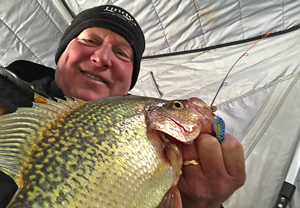 Patterns For Catching Mid-Winter Crappies At Lake of the Woods, Northwest Angle - Jeff Sundin
Patterns For Catching Mid-Winter Crappies At Lake of the Woods, Northwest Angle - Jeff Sundin
The average Lake of the Woods Crappie is nice, really nice. Catching fish in the 12 to 14 inch range is common and for those who fish persistently, fish over 15 inches are available in good numbers.
Crappie fishing on Lake of the Woods occurs primarily on the Canadian side of the lake and much of it is in remote territory. We travel by snowmobile and use portable ice fishing shelters because it allows us to strike out on our own to fish in quiet territory. But you don’t necessarily need to be geared up with snow machines and portables to fish for crappies. The easy way to get in on some great crappie fishing is to set up an ice fishing charter.
We always stay at Flag Island Resort when we fish Canadian waters. We love it there because the cabins are warm and comfortable, the food at the lodge is always good and their customer service is unsurpassed. They offer guided trips and ice shelter rentals for crappie, walleye and sauger on both the US and Canadian sides of the lake. All you have to do is make a phone call, book a trip and you’re on your way.
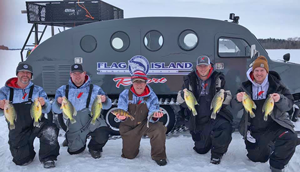 When we stay there, I watch their fishing groups return to the landing at dark. It never fails, soon after the anglers walk up the stairs, the fish cleaning shack lights up and the guides start cleaning fish.
When we stay there, I watch their fishing groups return to the landing at dark. It never fails, soon after the anglers walk up the stairs, the fish cleaning shack lights up and the guides start cleaning fish.
If you do prefer more adventure, bring your snowmobile, a solid portable ice shelter and a good graph that has GPS with reliable charts. My Helix 7 is indispensable because the screen is large enough to allow a good wide view of the charts. In my experience, the Lakemaster Charts have been very accurate, matching up perfectly with the structure in areas we’ve fished.
Not unlike locating crappies in other northern waters, finding deep water holes located close to structure is the key to catching fish consistently. The key depth is commonly 30 to 35 feet, setting my depth highlight on the Helix to 32 feet and then setting the highlight range to + or – 2 feet will highlight any spot between 30 and 34 feet. We look at these shaded areas that match our search criteria and fish any interesting looking spot that’s within reasonable travel distances.
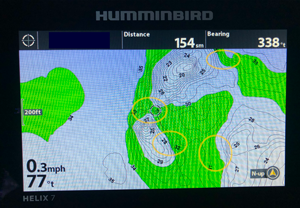 Some of the better fishing we’ve had was located over smaller, isolated holes that lay adjacent to points that lead into shallow water. At times the fish do locate over the middle of the holes, but more often than not, they are relating closer to structure. The tip of a point, a rising rock pile or a steep breakline that straddles the transition between deep and shallow water are all key areas to check out.
Some of the better fishing we’ve had was located over smaller, isolated holes that lay adjacent to points that lead into shallow water. At times the fish do locate over the middle of the holes, but more often than not, they are relating closer to structure. The tip of a point, a rising rock pile or a steep breakline that straddles the transition between deep and shallow water are all key areas to check out.
With success, comes responsibility. Catching fish in water depths of 30 feet or more will almost certainly result in the death of your quarry. When you intend to harvest some fish to eat, I believe that’s fine and you should go ahead and do it. But understand that once you’ve harvested what you can use, catch and release fishing is not an option. Even fish that swim away won’t typically survive very long. The best practice is to leave the rest of the fish alone and then go try for walleye or sauger, there’s plenty of those to catch up there too.
One really great way we use to tip the odds in favor of catching larger fish is to use large lures for crappie presentations. In some circles, there’s a misperception that crappies respond best to small lures, dressed only with tidbits of bait or tiny artificial tails. While it’s true that small lures do catch a lot of crappies, large lures do too and this is the time and place to use them. Often, the use of big baits helps me “weed out” strikes from small fish while encouraging strikes from large ones.
Over the past couple ice fishing seasons, Lindy’s Glow Spoon has really helped me accomplish this. I've written before that there's something about this lure that's struck a nerve with fish. It's true, Lake of the Woods crappies like them just as much as fish fish in my home territory do. The larger, fatter profile of the lure combined with the soft colors from the inner glow attracts the fish’s attention. On our most recent trip, we bulked up the Glow Spoons even more by tipping every hook with a wax worm.
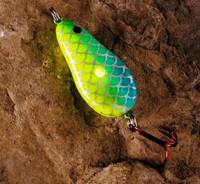 That’s an important tip because while crappies do like a bit of subtle action, they typically do not like the type of aggressive jigging that we’d often use to catch walleyes. Using a subtle wiggling motion gave the waxies a nice soft dancing action that triggered strikes. Remember to tone down your jigging motion when you fish for crappies.
That’s an important tip because while crappies do like a bit of subtle action, they typically do not like the type of aggressive jigging that we’d often use to catch walleyes. Using a subtle wiggling motion gave the waxies a nice soft dancing action that triggered strikes. Remember to tone down your jigging motion when you fish for crappies.
Timing the bite on Lake of the Woods is a different than what I’m accustomed too. Most of the lakes that I fish in north central Minnesota have fairly clear water. The water in Lake of the Woods is stained and somewhat cloudy. That cloudy water, combined with thick ice and heavy snow cover make it pretty dark down at 30 feet deep. The darker conditions lend themselves to better fishing during midday. The old reliable early morning, late afternoon pattern that works well on clear water lakes is much less prevalent on LOW. On our most recent trip, crappies were the most active between 11:30 Am and 2:30 PM. If we weren't out there for the mid day bite, we would have missed the opportunity completely.
Summing it all up, the crappie fishing is definitely one great reason to fish Lake of the Woods Northwest Angle. It's a rare day that you won't catch enough fish for a meal and there's always a great chance that you'll bag a trophy fish in the process. Whether you're a casual angler or a seasoned pro, there's a way to access the opportunity and the accomodations are first rate.
For more information about ice fishing the northwest Angle, check in with the folks at Flag Island Resort, they’ll be more than happy to chat with you, I promise. >> Flag Island Resort, Lake of the Woods Northwest Angle 218-223-8011
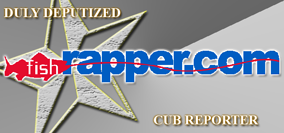 Join And Become A Duly Deputized Fishrapper Cub Reporter
Join And Become A Duly Deputized Fishrapper Cub Reporter
Helping your fellow fishermen and women stay abreast of the fishing conditions in your area is good for everyone and it's easier than you think!
Fishing Reports Minnesota is the Facebook counterpart to this page and it's open to the public. Be like me, become a duly deputized "Cub Reporter" and post your own pics and comments. If it's good for fishing, then it's Good For Everybody!